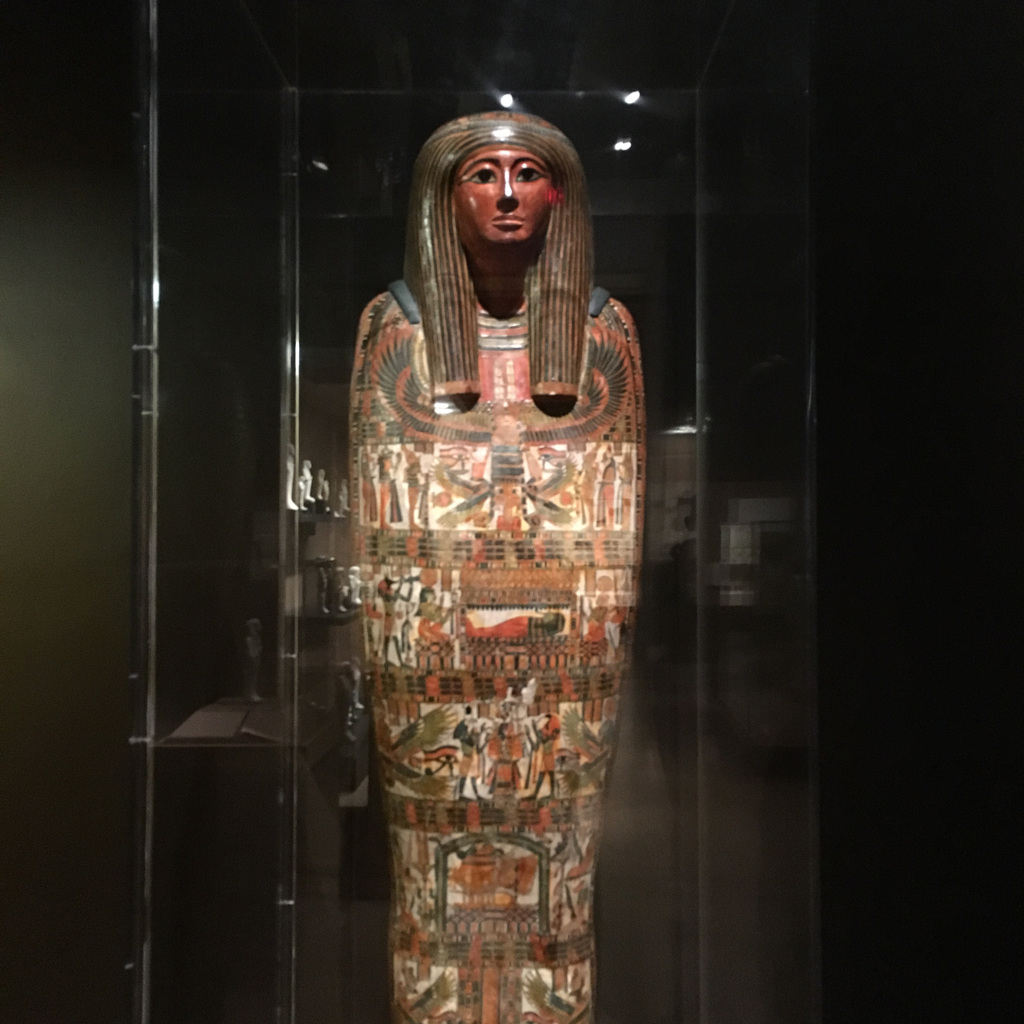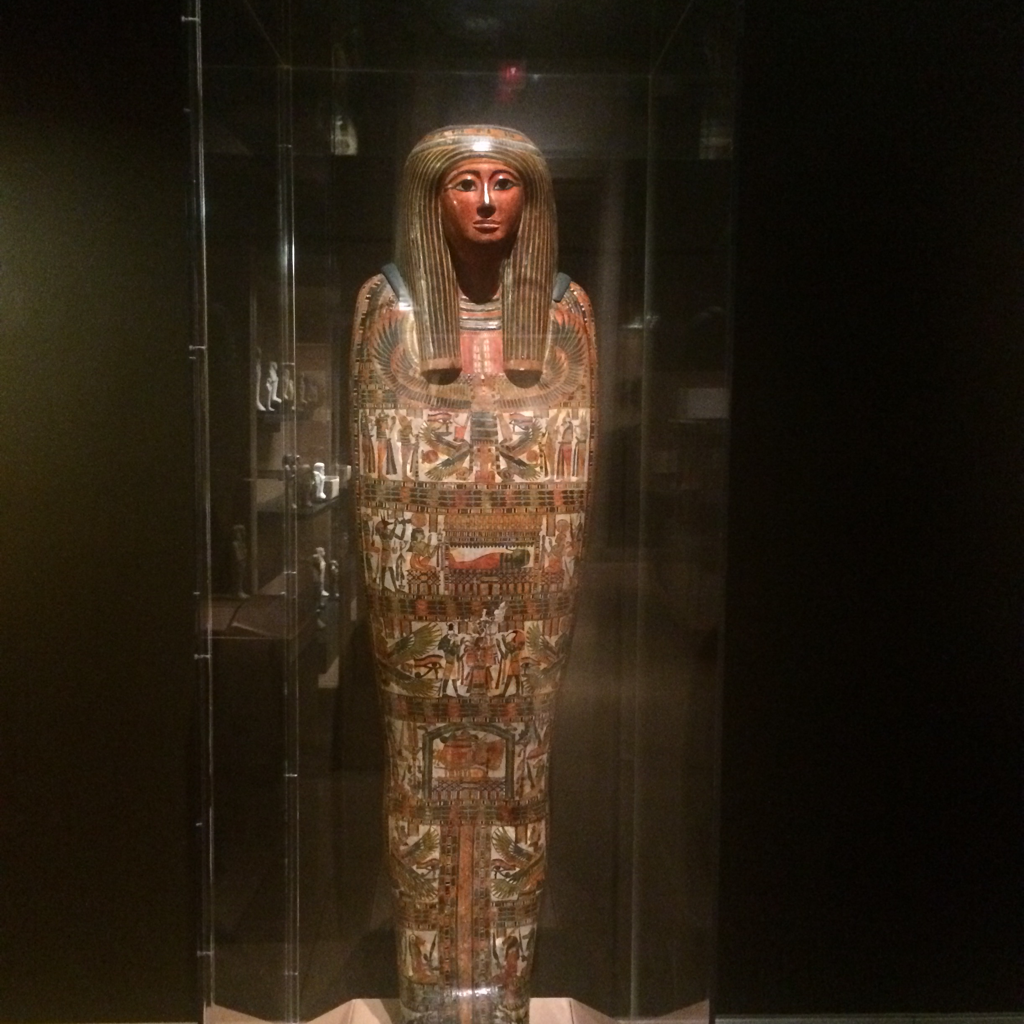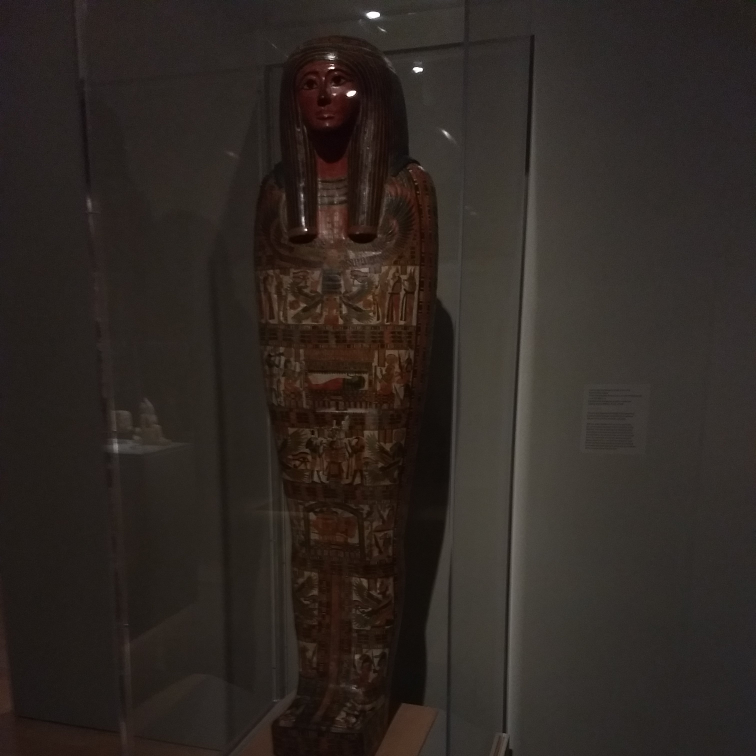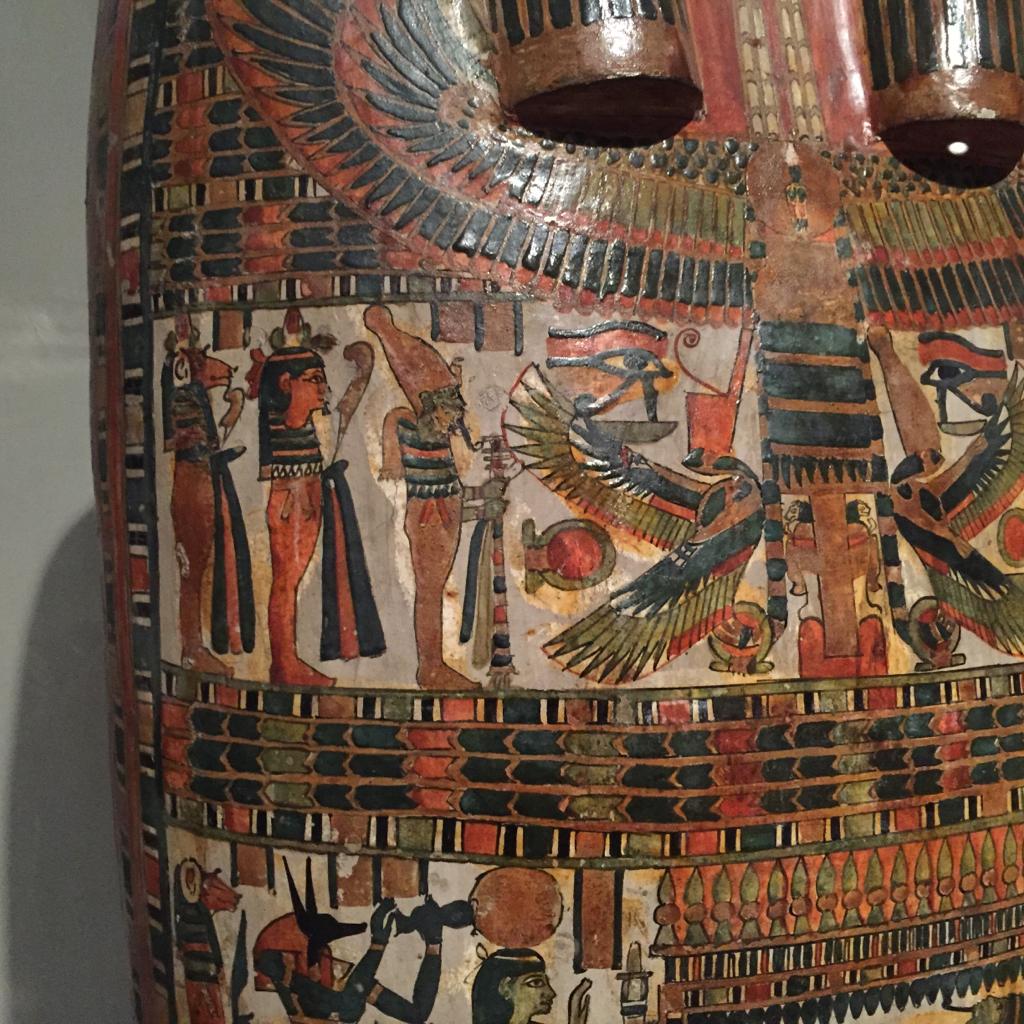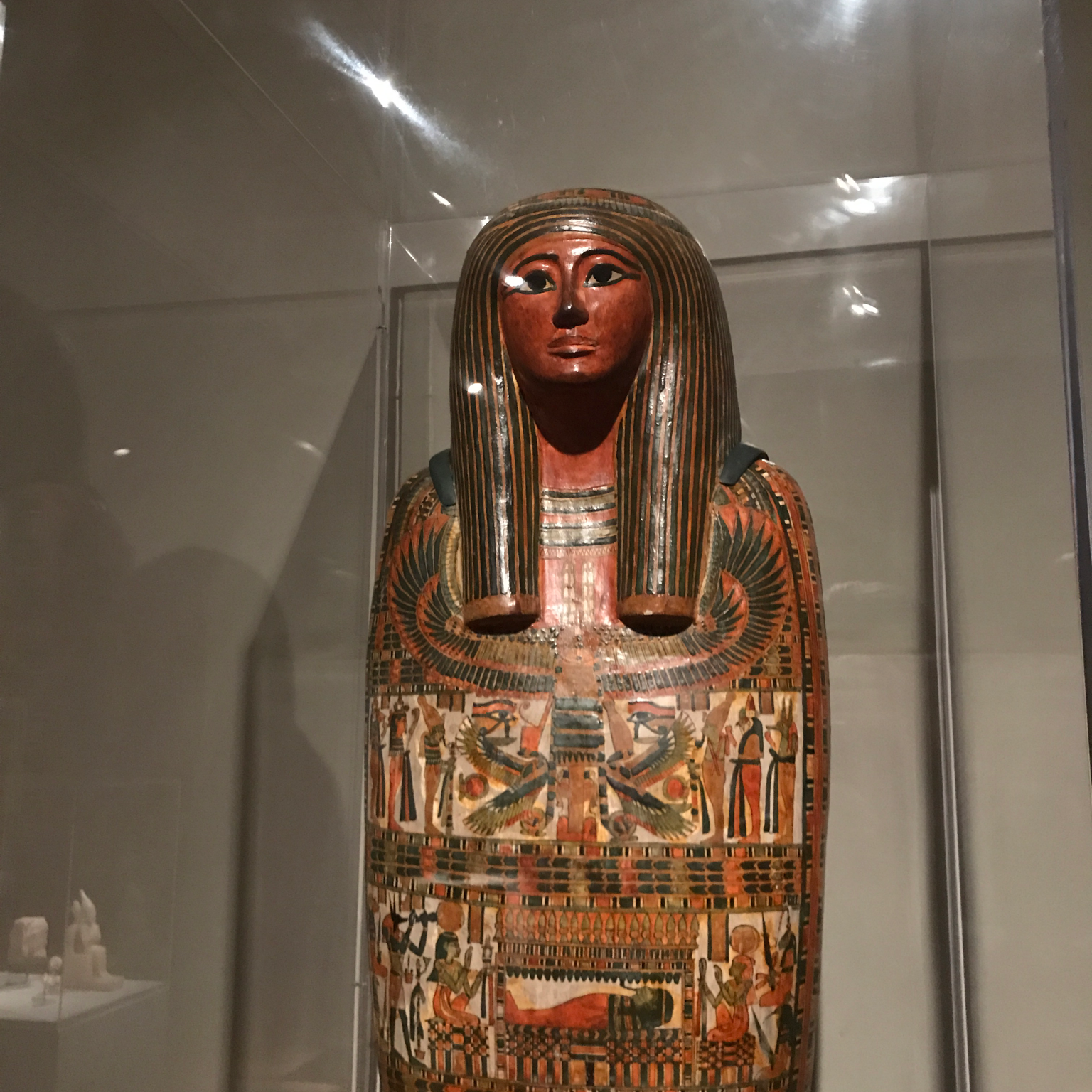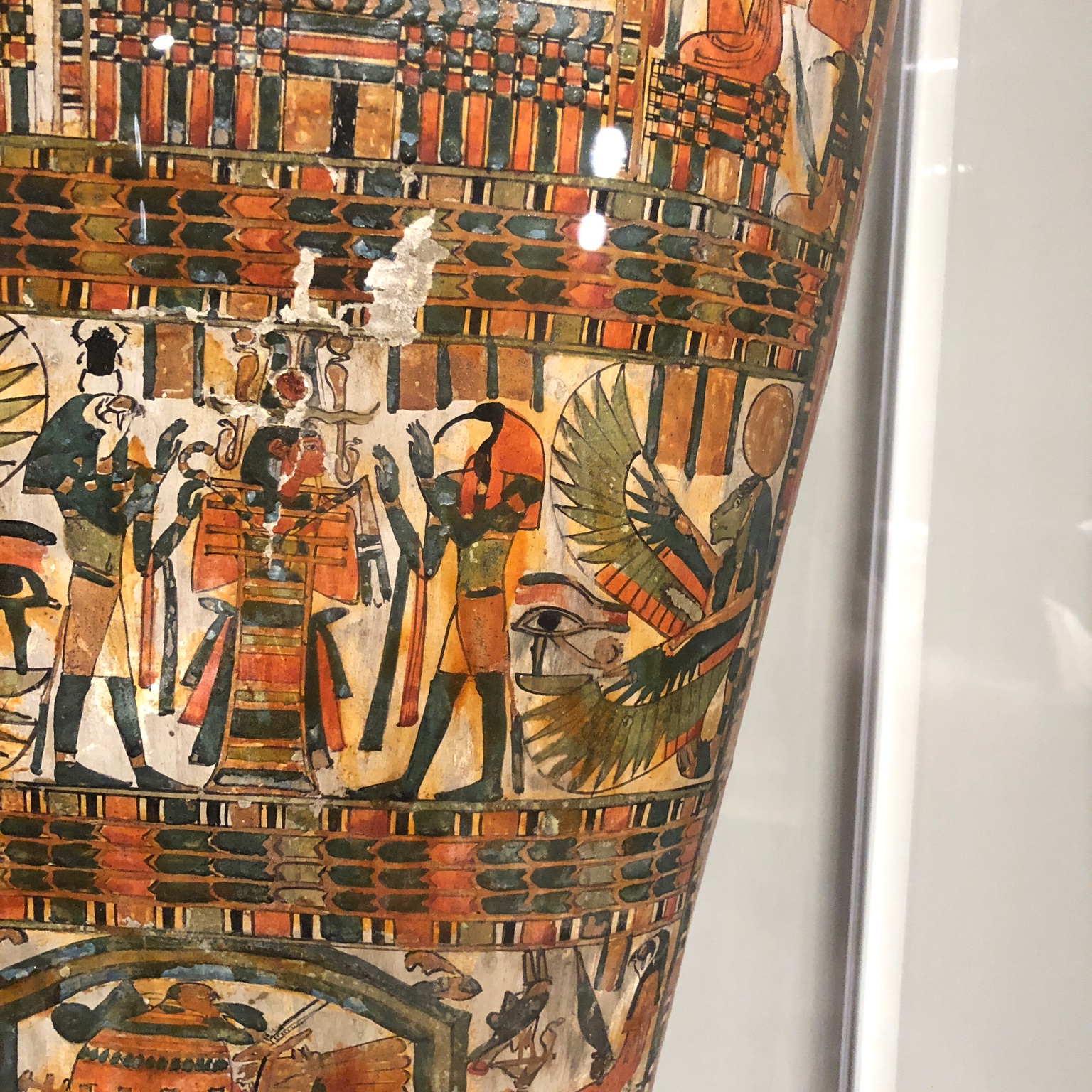

Egyptian. Mummy and Cartonnage of Hor, 798 B.C.E.–558 B.C.E. Linen, pigment, gesso, human remains, 69 1/2 x 18 x 13 in. (176.5 x 45.7 x 33 cm). Brooklyn Museum, Charles Edwin Wilbour Fund, 37.50E. Creative Commons-BY (Photo: Brooklyn Museum, 37.50E.jpg)

Egyptian. Mummy and Cartonnage of Hor, 798 B.C.E.–558 B.C.E. Linen, pigment, gesso, human remains, 69 1/2 x 18 x 13 in. (176.5 x 45.7 x 33 cm). Brooklyn Museum, Charles Edwin Wilbour Fund, 37.50E. Creative Commons-BY (Photo: Brooklyn Museum, CUR.37.50E_negA_bw.jpg)

Egyptian. Mummy and Cartonnage of Hor, 798 B.C.E.–558 B.C.E. Linen, pigment, gesso, human remains, 69 1/2 x 18 x 13 in. (176.5 x 45.7 x 33 cm). Brooklyn Museum, Charles Edwin Wilbour Fund, 37.50E. Creative Commons-BY (Photo: Karl Rudisill, Duggal Visual Solutions, 37.50E_CAT_scan_composite_xrs_Duggal_photograph.jpg)

Egyptian. Mummy and Cartonnage of Hor, 798 B.C.E.–558 B.C.E. Linen, pigment, gesso, human remains, 69 1/2 x 18 x 13 in. (176.5 x 45.7 x 33 cm). Brooklyn Museum, Charles Edwin Wilbour Fund, 37.50E. Creative Commons-BY (Photo: Karl Rudisill, Duggal Visual Solutions, 37.50E_composite_xrs_Duggal_photograph.jpg)

Egyptian. Mummy and Cartonnage of Hor, 798 B.C.E.–558 B.C.E. Linen, pigment, gesso, human remains, 69 1/2 x 18 x 13 in. (176.5 x 45.7 x 33 cm). Brooklyn Museum, Charles Edwin Wilbour Fund, 37.50E. Creative Commons-BY (Photo: Brooklyn Museum, CUR.37.50E_view1.jpg)

Egyptian. Mummy and Cartonnage of Hor, 798 B.C.E.–558 B.C.E. Linen, pigment, gesso, human remains, 69 1/2 x 18 x 13 in. (176.5 x 45.7 x 33 cm). Brooklyn Museum, Charles Edwin Wilbour Fund, 37.50E. Creative Commons-BY (Photo: Brooklyn Museum, CUR.37.50E_wwg8.jpg)

Egyptian. Mummy and Cartonnage of Hor, 798 B.C.E.–558 B.C.E. Linen, pigment, gesso, human remains, 69 1/2 x 18 x 13 in. (176.5 x 45.7 x 33 cm). Brooklyn Museum, Charles Edwin Wilbour Fund, 37.50E. Creative Commons-BY (Photo: Brooklyn Museum, CUR.37.50E_back.jpg)

Egyptian. Mummy and Cartonnage of Hor, 798 B.C.E.–558 B.C.E. Linen, pigment, gesso, human remains, 69 1/2 x 18 x 13 in. (176.5 x 45.7 x 33 cm). Brooklyn Museum, Charles Edwin Wilbour Fund, 37.50E. Creative Commons-BY (Photo: Brooklyn Museum, CUR.37.50E_front.jpg)

Egyptian. Mummy and Cartonnage of Hor, 798 B.C.E.–558 B.C.E. Linen, pigment, gesso, human remains, 69 1/2 x 18 x 13 in. (176.5 x 45.7 x 33 cm). Brooklyn Museum, Charles Edwin Wilbour Fund, 37.50E. Creative Commons-BY (Photo: Brooklyn Museum, CUR.37.50E_left.jpg)

Egyptian. Mummy and Cartonnage of Hor, 798 B.C.E.–558 B.C.E. Linen, pigment, gesso, human remains, 69 1/2 x 18 x 13 in. (176.5 x 45.7 x 33 cm). Brooklyn Museum, Charles Edwin Wilbour Fund, 37.50E. Creative Commons-BY (Photo: Brooklyn Museum, CUR.37.50E_left_view1.jpg)

Egyptian. Mummy and Cartonnage of Hor, 798 B.C.E.–558 B.C.E. Linen, pigment, gesso, human remains, 69 1/2 x 18 x 13 in. (176.5 x 45.7 x 33 cm). Brooklyn Museum, Charles Edwin Wilbour Fund, 37.50E. Creative Commons-BY (Photo: Brooklyn Museum, CUR.37.50E_left_view2.jpg)

Egyptian. Mummy and Cartonnage of Hor, 798 B.C.E.–558 B.C.E. Linen, pigment, gesso, human remains, 69 1/2 x 18 x 13 in. (176.5 x 45.7 x 33 cm). Brooklyn Museum, Charles Edwin Wilbour Fund, 37.50E. Creative Commons-BY (Photo: Brooklyn Museum, CUR.37.50E_left_view3.jpg)

Egyptian. Mummy and Cartonnage of Hor, 798 B.C.E.–558 B.C.E. Linen, pigment, gesso, human remains, 69 1/2 x 18 x 13 in. (176.5 x 45.7 x 33 cm). Brooklyn Museum, Charles Edwin Wilbour Fund, 37.50E. Creative Commons-BY (Photo: Brooklyn Museum, CUR.37.50E_left_view4.jpg)

Egyptian. Mummy and Cartonnage of Hor, 798 B.C.E.–558 B.C.E. Linen, pigment, gesso, human remains, 69 1/2 x 18 x 13 in. (176.5 x 45.7 x 33 cm). Brooklyn Museum, Charles Edwin Wilbour Fund, 37.50E. Creative Commons-BY (Photo: Brooklyn Museum, CUR.37.50E_left_view5.jpg)

Egyptian. Mummy and Cartonnage of Hor, 798 B.C.E.–558 B.C.E. Linen, pigment, gesso, human remains, 69 1/2 x 18 x 13 in. (176.5 x 45.7 x 33 cm). Brooklyn Museum, Charles Edwin Wilbour Fund, 37.50E. Creative Commons-BY (Photo: Brooklyn Museum, CUR.37.50E_left_view6.jpg)

Egyptian. Mummy and Cartonnage of Hor, 798 B.C.E.–558 B.C.E. Linen, pigment, gesso, human remains, 69 1/2 x 18 x 13 in. (176.5 x 45.7 x 33 cm). Brooklyn Museum, Charles Edwin Wilbour Fund, 37.50E. Creative Commons-BY (Photo: Brooklyn Museum, CUR.37.50E_left_view7.jpg)

Egyptian. Mummy and Cartonnage of Hor, 798 B.C.E.–558 B.C.E. Linen, pigment, gesso, human remains, 69 1/2 x 18 x 13 in. (176.5 x 45.7 x 33 cm). Brooklyn Museum, Charles Edwin Wilbour Fund, 37.50E. Creative Commons-BY (Photo: Brooklyn Museum, CUR.37.50E_left_view8.jpg)

Egyptian. Mummy and Cartonnage of Hor, 798 B.C.E.–558 B.C.E. Linen, pigment, gesso, human remains, 69 1/2 x 18 x 13 in. (176.5 x 45.7 x 33 cm). Brooklyn Museum, Charles Edwin Wilbour Fund, 37.50E. Creative Commons-BY (Photo: Brooklyn Museum, CUR.37.50E_left_view9.jpg)

Egyptian. Mummy and Cartonnage of Hor, 798 B.C.E.–558 B.C.E. Linen, pigment, gesso, human remains, 69 1/2 x 18 x 13 in. (176.5 x 45.7 x 33 cm). Brooklyn Museum, Charles Edwin Wilbour Fund, 37.50E. Creative Commons-BY (Photo: Brooklyn Museum, CUR.37.50E_middle_left_view1.jpg)

Egyptian. Mummy and Cartonnage of Hor, 798 B.C.E.–558 B.C.E. Linen, pigment, gesso, human remains, 69 1/2 x 18 x 13 in. (176.5 x 45.7 x 33 cm). Brooklyn Museum, Charles Edwin Wilbour Fund, 37.50E. Creative Commons-BY (Photo: Brooklyn Museum, CUR.37.50E_middle_left_view2.jpg)

Egyptian. Mummy and Cartonnage of Hor, 798 B.C.E.–558 B.C.E. Linen, pigment, gesso, human remains, 69 1/2 x 18 x 13 in. (176.5 x 45.7 x 33 cm). Brooklyn Museum, Charles Edwin Wilbour Fund, 37.50E. Creative Commons-BY (Photo: Brooklyn Museum, CUR.37.50E_middle_left_view3.jpg)

Egyptian. Mummy and Cartonnage of Hor, 798 B.C.E.–558 B.C.E. Linen, pigment, gesso, human remains, 69 1/2 x 18 x 13 in. (176.5 x 45.7 x 33 cm). Brooklyn Museum, Charles Edwin Wilbour Fund, 37.50E. Creative Commons-BY (Photo: Brooklyn Museum, CUR.37.50E_middle_left_view4.jpg)

Egyptian. Mummy and Cartonnage of Hor, 798 B.C.E.–558 B.C.E. Linen, pigment, gesso, human remains, 69 1/2 x 18 x 13 in. (176.5 x 45.7 x 33 cm). Brooklyn Museum, Charles Edwin Wilbour Fund, 37.50E. Creative Commons-BY (Photo: Brooklyn Museum, CUR.37.50E_middle_left_view5.jpg)

Egyptian. Mummy and Cartonnage of Hor, 798 B.C.E.–558 B.C.E. Linen, pigment, gesso, human remains, 69 1/2 x 18 x 13 in. (176.5 x 45.7 x 33 cm). Brooklyn Museum, Charles Edwin Wilbour Fund, 37.50E. Creative Commons-BY (Photo: Brooklyn Museum, CUR.37.50E_middle_left_view6.jpg)

Egyptian. Mummy and Cartonnage of Hor, 798 B.C.E.–558 B.C.E. Linen, pigment, gesso, human remains, 69 1/2 x 18 x 13 in. (176.5 x 45.7 x 33 cm). Brooklyn Museum, Charles Edwin Wilbour Fund, 37.50E. Creative Commons-BY (Photo: Brooklyn Museum, CUR.37.50E_middle_left_view7.jpg)

Egyptian. Mummy and Cartonnage of Hor, 798 B.C.E.–558 B.C.E. Linen, pigment, gesso, human remains, 69 1/2 x 18 x 13 in. (176.5 x 45.7 x 33 cm). Brooklyn Museum, Charles Edwin Wilbour Fund, 37.50E. Creative Commons-BY (Photo: Brooklyn Museum, CUR.37.50E_middle_right_view1.jpg)

Egyptian. Mummy and Cartonnage of Hor, 798 B.C.E.–558 B.C.E. Linen, pigment, gesso, human remains, 69 1/2 x 18 x 13 in. (176.5 x 45.7 x 33 cm). Brooklyn Museum, Charles Edwin Wilbour Fund, 37.50E. Creative Commons-BY (Photo: Brooklyn Museum, CUR.37.50E_middle_right_view2.jpg)

Egyptian. Mummy and Cartonnage of Hor, 798 B.C.E.–558 B.C.E. Linen, pigment, gesso, human remains, 69 1/2 x 18 x 13 in. (176.5 x 45.7 x 33 cm). Brooklyn Museum, Charles Edwin Wilbour Fund, 37.50E. Creative Commons-BY (Photo: Brooklyn Museum, CUR.37.50E_middle_right_view3.jpg)

Egyptian. Mummy and Cartonnage of Hor, 798 B.C.E.–558 B.C.E. Linen, pigment, gesso, human remains, 69 1/2 x 18 x 13 in. (176.5 x 45.7 x 33 cm). Brooklyn Museum, Charles Edwin Wilbour Fund, 37.50E. Creative Commons-BY (Photo: Brooklyn Museum, CUR.37.50E_middle_right_view4.jpg)

Egyptian. Mummy and Cartonnage of Hor, 798 B.C.E.–558 B.C.E. Linen, pigment, gesso, human remains, 69 1/2 x 18 x 13 in. (176.5 x 45.7 x 33 cm). Brooklyn Museum, Charles Edwin Wilbour Fund, 37.50E. Creative Commons-BY (Photo: Brooklyn Museum, CUR.37.50E_middle_right_view5.jpg)

Egyptian. Mummy and Cartonnage of Hor, 798 B.C.E.–558 B.C.E. Linen, pigment, gesso, human remains, 69 1/2 x 18 x 13 in. (176.5 x 45.7 x 33 cm). Brooklyn Museum, Charles Edwin Wilbour Fund, 37.50E. Creative Commons-BY (Photo: Brooklyn Museum, CUR.37.50E_middle_right_view6.jpg)

Egyptian. Mummy and Cartonnage of Hor, 798 B.C.E.–558 B.C.E. Linen, pigment, gesso, human remains, 69 1/2 x 18 x 13 in. (176.5 x 45.7 x 33 cm). Brooklyn Museum, Charles Edwin Wilbour Fund, 37.50E. Creative Commons-BY (Photo: Brooklyn Museum, CUR.37.50E_middle_view01.jpg)

Egyptian. Mummy and Cartonnage of Hor, 798 B.C.E.–558 B.C.E. Linen, pigment, gesso, human remains, 69 1/2 x 18 x 13 in. (176.5 x 45.7 x 33 cm). Brooklyn Museum, Charles Edwin Wilbour Fund, 37.50E. Creative Commons-BY (Photo: Brooklyn Museum, CUR.37.50E_middle_view02.jpg)

Egyptian. Mummy and Cartonnage of Hor, 798 B.C.E.–558 B.C.E. Linen, pigment, gesso, human remains, 69 1/2 x 18 x 13 in. (176.5 x 45.7 x 33 cm). Brooklyn Museum, Charles Edwin Wilbour Fund, 37.50E. Creative Commons-BY (Photo: Brooklyn Museum, CUR.37.50E_middle_view03.jpg)

Egyptian. Mummy and Cartonnage of Hor, 798 B.C.E.–558 B.C.E. Linen, pigment, gesso, human remains, 69 1/2 x 18 x 13 in. (176.5 x 45.7 x 33 cm). Brooklyn Museum, Charles Edwin Wilbour Fund, 37.50E. Creative Commons-BY (Photo: Brooklyn Museum, CUR.37.50E_middle_view04.jpg)

Egyptian. Mummy and Cartonnage of Hor, 798 B.C.E.–558 B.C.E. Linen, pigment, gesso, human remains, 69 1/2 x 18 x 13 in. (176.5 x 45.7 x 33 cm). Brooklyn Museum, Charles Edwin Wilbour Fund, 37.50E. Creative Commons-BY (Photo: Brooklyn Museum, CUR.37.50E_middle_view05.jpg)

Egyptian. Mummy and Cartonnage of Hor, 798 B.C.E.–558 B.C.E. Linen, pigment, gesso, human remains, 69 1/2 x 18 x 13 in. (176.5 x 45.7 x 33 cm). Brooklyn Museum, Charles Edwin Wilbour Fund, 37.50E. Creative Commons-BY (Photo: Brooklyn Museum, CUR.37.50E_middle_view06.jpg)

Egyptian. Mummy and Cartonnage of Hor, 798 B.C.E.–558 B.C.E. Linen, pigment, gesso, human remains, 69 1/2 x 18 x 13 in. (176.5 x 45.7 x 33 cm). Brooklyn Museum, Charles Edwin Wilbour Fund, 37.50E. Creative Commons-BY (Photo: Brooklyn Museum, CUR.37.50E_middle_view07.jpg)

Egyptian. Mummy and Cartonnage of Hor, 798 B.C.E.–558 B.C.E. Linen, pigment, gesso, human remains, 69 1/2 x 18 x 13 in. (176.5 x 45.7 x 33 cm). Brooklyn Museum, Charles Edwin Wilbour Fund, 37.50E. Creative Commons-BY (Photo: Brooklyn Museum, CUR.37.50E_middle_view08.jpg)

Egyptian. Mummy and Cartonnage of Hor, 798 B.C.E.–558 B.C.E. Linen, pigment, gesso, human remains, 69 1/2 x 18 x 13 in. (176.5 x 45.7 x 33 cm). Brooklyn Museum, Charles Edwin Wilbour Fund, 37.50E. Creative Commons-BY (Photo: Brooklyn Museum, CUR.37.50E_middle_view09.jpg)

Egyptian. Mummy and Cartonnage of Hor, 798 B.C.E.–558 B.C.E. Linen, pigment, gesso, human remains, 69 1/2 x 18 x 13 in. (176.5 x 45.7 x 33 cm). Brooklyn Museum, Charles Edwin Wilbour Fund, 37.50E. Creative Commons-BY (Photo: Brooklyn Museum, CUR.37.50E_middle_view10.jpg)

Egyptian. Mummy and Cartonnage of Hor, 798 B.C.E.–558 B.C.E. Linen, pigment, gesso, human remains, 69 1/2 x 18 x 13 in. (176.5 x 45.7 x 33 cm). Brooklyn Museum, Charles Edwin Wilbour Fund, 37.50E. Creative Commons-BY (Photo: Brooklyn Museum, CUR.37.50E_middle_view11.jpg)

Egyptian. Mummy and Cartonnage of Hor, 798 B.C.E.–558 B.C.E. Linen, pigment, gesso, human remains, 69 1/2 x 18 x 13 in. (176.5 x 45.7 x 33 cm). Brooklyn Museum, Charles Edwin Wilbour Fund, 37.50E. Creative Commons-BY (Photo: Brooklyn Museum, CUR.37.50E_middle_view12.jpg)

Egyptian. Mummy and Cartonnage of Hor, 798 B.C.E.–558 B.C.E. Linen, pigment, gesso, human remains, 69 1/2 x 18 x 13 in. (176.5 x 45.7 x 33 cm). Brooklyn Museum, Charles Edwin Wilbour Fund, 37.50E. Creative Commons-BY (Photo: Brooklyn Museum, CUR.37.50E_right.jpg)

Egyptian. Mummy and Cartonnage of Hor, 798 B.C.E.–558 B.C.E. Linen, pigment, gesso, human remains, 69 1/2 x 18 x 13 in. (176.5 x 45.7 x 33 cm). Brooklyn Museum, Charles Edwin Wilbour Fund, 37.50E. Creative Commons-BY (Photo: Brooklyn Museum, CUR.37.50E_right_view1.jpg)

Egyptian. Mummy and Cartonnage of Hor, 798 B.C.E.–558 B.C.E. Linen, pigment, gesso, human remains, 69 1/2 x 18 x 13 in. (176.5 x 45.7 x 33 cm). Brooklyn Museum, Charles Edwin Wilbour Fund, 37.50E. Creative Commons-BY (Photo: Brooklyn Museum, CUR.37.50E_right_view2.jpg)

Egyptian. Mummy and Cartonnage of Hor, 798 B.C.E.–558 B.C.E. Linen, pigment, gesso, human remains, 69 1/2 x 18 x 13 in. (176.5 x 45.7 x 33 cm). Brooklyn Museum, Charles Edwin Wilbour Fund, 37.50E. Creative Commons-BY (Photo: Brooklyn Museum, CUR.37.50E_right_view3.jpg)

Egyptian. Mummy and Cartonnage of Hor, 798 B.C.E.–558 B.C.E. Linen, pigment, gesso, human remains, 69 1/2 x 18 x 13 in. (176.5 x 45.7 x 33 cm). Brooklyn Museum, Charles Edwin Wilbour Fund, 37.50E. Creative Commons-BY (Photo: Brooklyn Museum, CUR.37.50E_right_view4.jpg)

Egyptian. Mummy and Cartonnage of Hor, 798 B.C.E.–558 B.C.E. Linen, pigment, gesso, human remains, 69 1/2 x 18 x 13 in. (176.5 x 45.7 x 33 cm). Brooklyn Museum, Charles Edwin Wilbour Fund, 37.50E. Creative Commons-BY (Photo: Brooklyn Museum, CUR.37.50E_right_view5.jpg)

Egyptian. Mummy and Cartonnage of Hor, 798 B.C.E.–558 B.C.E. Linen, pigment, gesso, human remains, 69 1/2 x 18 x 13 in. (176.5 x 45.7 x 33 cm). Brooklyn Museum, Charles Edwin Wilbour Fund, 37.50E. Creative Commons-BY (Photo: Brooklyn Museum, CUR.37.50E_right_view6.jpg)

Egyptian. Mummy and Cartonnage of Hor, 798 B.C.E.–558 B.C.E. Linen, pigment, gesso, human remains, 69 1/2 x 18 x 13 in. (176.5 x 45.7 x 33 cm). Brooklyn Museum, Charles Edwin Wilbour Fund, 37.50E. Creative Commons-BY (Photo: Brooklyn Museum, CUR.37.50E_right_view7.jpg)

Egyptian. Mummy and Cartonnage of Hor, 798 B.C.E.–558 B.C.E. Linen, pigment, gesso, human remains, 69 1/2 x 18 x 13 in. (176.5 x 45.7 x 33 cm). Brooklyn Museum, Charles Edwin Wilbour Fund, 37.50E. Creative Commons-BY (Photo: Brooklyn Museum, CUR.37.50E_right_view8.jpg)

Egyptian. Mummy and Cartonnage of Hor, 798 B.C.E.–558 B.C.E. Linen, pigment, gesso, human remains, 69 1/2 x 18 x 13 in. (176.5 x 45.7 x 33 cm). Brooklyn Museum, Charles Edwin Wilbour Fund, 37.50E. Creative Commons-BY (Photo: Brooklyn Museum, CUR.37.50E_right_view9.jpg)

Egyptian. Mummy and Cartonnage of Hor, 798 B.C.E.–558 B.C.E. Linen, pigment, gesso, human remains, 69 1/2 x 18 x 13 in. (176.5 x 45.7 x 33 cm). Brooklyn Museum, Charles Edwin Wilbour Fund, 37.50E. Creative Commons-BY (Photo: Brooklyn Museum, CUR.37.50E_negC_bw.jpg)

Egyptian. Mummy and Cartonnage of Hor, 798 B.C.E.–558 B.C.E. Linen, pigment, gesso, human remains, 69 1/2 x 18 x 13 in. (176.5 x 45.7 x 33 cm). Brooklyn Museum, Charles Edwin Wilbour Fund, 37.50E. Creative Commons-BY (Photo: Brooklyn Museum, 37.50E_NegA_bw.jpg)

Egyptian. Mummy and Cartonnage of Hor, 798 B.C.E.–558 B.C.E. Linen, pigment, gesso, human remains, 69 1/2 x 18 x 13 in. (176.5 x 45.7 x 33 cm). Brooklyn Museum, Charles Edwin Wilbour Fund, 37.50E. Creative Commons-BY (Photo: Brooklyn Museum, 37.50E_NegB_bw.jpg)

Egyptian. Mummy and Cartonnage of Hor, 798 B.C.E.–558 B.C.E. Linen, pigment, gesso, human remains, 69 1/2 x 18 x 13 in. (176.5 x 45.7 x 33 cm). Brooklyn Museum, Charles Edwin Wilbour Fund, 37.50E. Creative Commons-BY (Photo: Brooklyn Museum, 37.50E_NegC_bw.jpg)

Egyptian. Mummy and Cartonnage of Hor, 798 B.C.E.–558 B.C.E. Linen, pigment, gesso, human remains, 69 1/2 x 18 x 13 in. (176.5 x 45.7 x 33 cm). Brooklyn Museum, Charles Edwin Wilbour Fund, 37.50E. Creative Commons-BY (Photo: Brooklyn Museum, 37.50E_NegD_bw.jpg)

Egyptian. Mummy and Cartonnage of Hor, 798 B.C.E.–558 B.C.E. Linen, pigment, gesso, human remains, 69 1/2 x 18 x 13 in. (176.5 x 45.7 x 33 cm). Brooklyn Museum, Charles Edwin Wilbour Fund, 37.50E. Creative Commons-BY (Photo: Brooklyn Museum, 37.50E_NegA_glass_bw_SL4.jpg)

Egyptian. Mummy and Cartonnage of Hor, 798 B.C.E.–558 B.C.E. Linen, pigment, gesso, human remains, 69 1/2 x 18 x 13 in. (176.5 x 45.7 x 33 cm). Brooklyn Museum, Charles Edwin Wilbour Fund, 37.50E. Creative Commons-BY (Photo: Brooklyn Museum, 37.50E_NegD_glass_bw_SL4.jpg)

Egyptian. Mummy and Cartonnage of Hor, 798 B.C.E.–558 B.C.E. Linen, pigment, gesso, human remains, 69 1/2 x 18 x 13 in. (176.5 x 45.7 x 33 cm). Brooklyn Museum, Charles Edwin Wilbour Fund, 37.50E. Creative Commons-BY (Photo: Brooklyn Museum, CUR.37.50E_mummychamber.jpg)

Egyptian. Mummy and Cartonnage of Hor, 798 B.C.E.–558 B.C.E. Linen, pigment, gesso, human remains, 69 1/2 x 18 x 13 in. (176.5 x 45.7 x 33 cm). Brooklyn Museum, Charles Edwin Wilbour Fund, 37.50E. Creative Commons-BY (Photo: , 37.50E_CAT_scan_composite_xrs_gray_Duggal_photograph.jpg)
Mummy and Cartonnage of Hor
Egyptian, Classical, Ancient Near Eastern Art
On View: Funerary Gallery 2, Martha A. and Robert S. Rubin Gallery, 3rd Floor
Various gods represented on a mummy case (or cartonnage) assisted in the transition to the afterlife. The role of each god in protecting the mummified individual and facilitating rebirth is exemplified by the animal head used to illustrate them. For instance, among the animal-headed deities depicted in a vertical line on either side of this mummy case, the falcon head symbolizes swiftness and keen eyesight, while the cow-headed deity is nurturing and protective.





